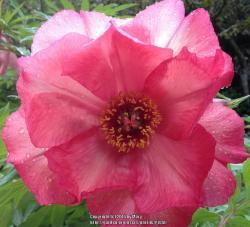Hi Liz.
I will chime in here with my thoughts. This is probably not at all useless or a waste. Azomite is just old volcanic ash that has been dug up and put in a bag. The idea is that it has a lot of different minerals in it, possibly your soil is depleted in one or more so it may be quite helpful. Soils do hold minerals, they are absorbed onto the clay particles, and the organic humus component and can be thus "saved" for later uptake by the plants. It is true that things wash through soils and are lost (this is why lawn fertilizer ends up causing algae blooms in nearby lakes) but this might not happen to you for two reasons:
1- It will freeze hard in Colorado very soon, so nothing there is leaching out (scientific term for being washed through the soil) because it is a solid block of ice.
2- Much of Colorado is very dry. I just logged into Weather Underground, it looks like you only get about 10" of precipitation a year. Hollingsworth Peonies is in Missouri where it rains a lot more (87" which is almost ten times what you get!). Colorado tends to have soils where stuff is not leached through, and Missouri has soils that developed in a leached situation. This is why lots of Colorado (and the American West) can grow such great crops when irrigated- the nutrients have built up in the top layers of soil so they are very fertile. The limiting thing has been water.
The end result of this is different farming/gardening situations are just that- different. Your technique may be great in your garden, and not a waste at all. At Hollingsworth Peonies he may have found fall application to be a waste of $, because of the high rainfall there.
As to the concern about toxic elements in the Azomite, that I am not sure of. There are measurable amounts of all kinds of elements in Azomite, like all volcanic material, I just do not know if this is a problem. Strontium is in all soils, not just volcanic soils. Certainly volcanic soils are used everywhere for agriculture. I guess I would have to do a careful web search about this, to see if any real research has been done to see if toxic amounts of Strontium or other metals could build up with regular use of Azomite. It can happen. For decades cotton fields in the south were treated with large amounts of arsenic to kill insects. Now those fields have been converted to rice paddies, and there really can be toxic levels of arsenic in the rice. The arsenic was held in the soil, and is easily released in a flooded rice paddy, to be taken up by the plants (take home point-eat California rice they never grew cotton there). But that was massive amounts of arsenic, spread on the fields for decades. A little bag of prehistoric volcanic ash seems like a trivial thing, in comparison.

